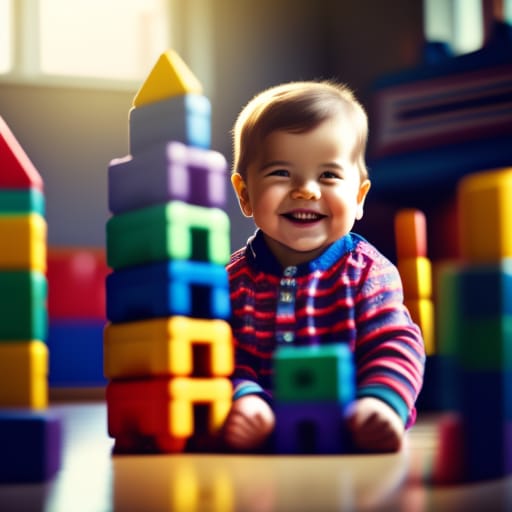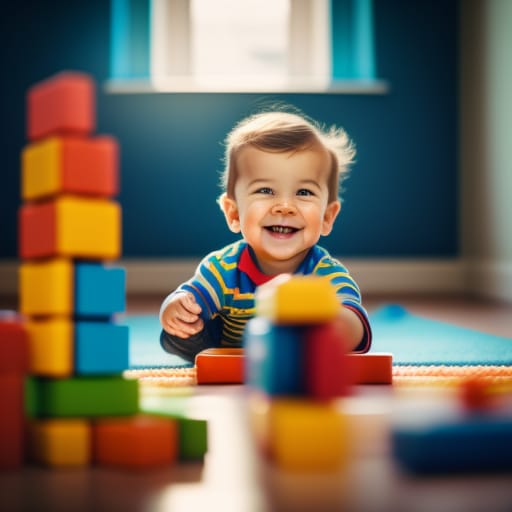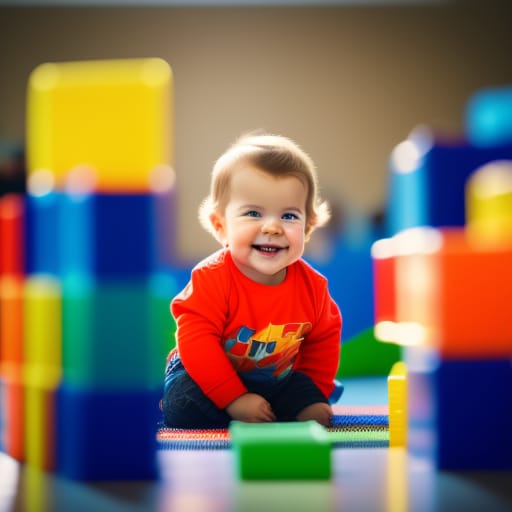Building blocks have been a beloved toy for generations of children. As a leading toy manufacturer, Fisher-Price has created some of the most iconic and educational building blocks on the market. This guide will explore the benefits of building blocks for early learning and introduce some of Fisher-Price’s most popular building block sets.

Why Building Blocks are Important for Young Children
Building blocks provide a wealth of learning opportunities and developmental benefits for babies and toddlers. Here are some of the key reasons these classic toys continue to thrive:
Promote Cognitive Development
- Building blocks are designed to inspire imagination, problem-solving, and critical thinking as children create, stack, and manipulate the blocks into various structures.
- Sorting blocks by size, shape, or color enhances cognitive skills like pattern recognition and categorization.
- Simple counting and arranging blocks in sequence fosters early math skills and understanding of numbers.
Enhance Motor Skills
- The hands-on, tactile experience of grasping, stacking, and manipulating blocks builds fine motor control.
- Gross motor skills are improved as children crawl, reach, and move around to play with blocks.
Language Development
- Block play provides the opportunity to learn new words and phrases by identifying shapes, and colors, and counting numbers out loud.
- Interactive blocks that make sounds, talk, or sing alphabet songs promote phonetic awareness.
Promotes Imagination and Creativity
- Open-ended block play allows children to build, arrange, and use blocks however they choose, fueling creativity and imaginative play.
- Blocks that represent different themes like animals, transportation, or buildings inspire creative stories and role play.
Social and Emotional Skills
- Sharing and cooperating with others during block play teaches important social skills.
- Expressing emotions like pride, frustration, or excitement helps develop self-regulation.
With all these advantages, it’s clear why building blocks have stood the test of time as an early learning toy. Many parents look to trusted brands like Fisher-Price for well-designed blocks that stimulate their child’s growth in a fun, engaging way.
An Introduction to Fisher-Price Building Blocks
Founded in 1930, Fisher-Price has a long legacy of creating high-quality, educational toys for infants and toddlers. Their diverse line of building blocks engages a child’s senses, imagination, and emerging cognitive abilities. Here’s an overview of some of their popular building block sets:
Laugh & Learn First Words Blocks
- Ages 9 mos+
- Plastic blocks feature words, numbers, colors, and images
- Interactive blocks play songs, phrases, and first words
- Promotes language, cognitive, and motor skills
- 30+ colorful blocks to stack and arrange
Smart Stages Building Blocks
- Ages 1-3 years
- Different sets like zoo, farm, or city themes
- Characters and block designs teach animals, objects, colors
- Promotes pretend play and language development
- Chunky easy-grip blocks for small hands
Mega Bloks Big Building Bag
- Ages 1-5 years
- 60-90 colorful oversized building blocks
- Encourages creativity, stacking, and building
- Different sizes, shapes, colors to categorize and sort
- Bag for easy clean-up and storage
Baby’s First Blocks
- Ages 6 mos+
- Colorful multi-sided blocks with different textures
- Easy to grasp, hold, and manipulate
- Introduces cause and effect
- Promotes motor skills and sensory exploration
Fisher-Price building blocks check all the boxes for an educational toy. Their hands-on sets build key developmental skills in a fun, engaging way through play.

Developmental Benefits of Fisher-Price Building Blocks
A closer look at some of Fisher-Price’s block sets reveals just how they promote learning across developmental domains in young children.
Laugh & Learn First Words Blocks
This interactive set develops language, cognitive, and motor skills.
- Language: Blocks play songs, words, letters, and phrases to build vocabulary and phonetic awareness
- Cognitive: Matching colors and sorting grows categorization. Sequencing promotes logic.
- Motor Skills: Easy-to-grasp blocks develop fine motor skills. Reaching, building, and crawling aid gross motor skills.
Smart Stages Building Blocks
Themed sets like farms, zoos, or cities encourage imagination and language.
- Imagination: Animal and character blocks inspire creative pretend play.
- Language: Learning new words and role-playing conversation skills.
- Motor Skills: Chunky blocks are easy for little hands to manipulate.
Mega Bloks Big Building Bag
With different sizes and shapes, this set enhances creativity, spatial, and motor skills.
- Creativity: Open-ended building play fuels imagination and storytelling.
- Spatial Skills: Stacking, balancing, and arranging grows spatial understanding.
- Motor Skills: Manipulating an array of chunky blocks builds dexterity.
Baby’s First Blocks
Multi-sensory blocks with colors, textures, and sounds engage exploration and the senses.
- Sensory play: Visual, tactile, and auditory input stimulates the senses.
- Cause & effect: Actions like shaking, dropping, and squeezing blocks teach cause-effect.
- Motor skills: Easy to grasp promotes object manipulation skills.
Well-designed building blocks transform play into an opportunity to learn foundational academic, motor, social, and thinking skills. Fisher-Price creates its blocks to align with key developmental milestones and learning objectives for babies and young toddlers.
Top Building Block Sets from Fisher-Price
Based on child development principles, Fisher-Price offers a wide selection of building blocks suited for different ages and skill levels. Here is an overview of some of their best-selling and top-rated building block sets:
Laugh & Learn Counting Blocks (9 mos+)
- 10 blocks with numbers 0-9 teach counting
- Blocks recognize when correctly sequenced and play songs & phrases
- Promotes number awareness, order, and early math
- Fun activities and modes to learn skills
- Around $15
Laugh & Learn First Words Blocks (9 mos+)
- 30+ blocks with words, letters, colors, and images
- Pressing a block plays the word, sound, song, or phrase
- Great for building vocabulary and language
- Different modes teach skills and number + word sequencing
- Under $25
Smart Stages Zoo Blocks (1-3 years)
- 20 blocks with a zoo theme teach animals and vocabulary
- Chunky blocks are easy for small hands to manipulate
- Windows reveal cute animals hidden inside the blocks
- Builds motor skills, language, and imaginative play
- Around $20
Mega Bloks Big Building Bag (1-5 years)
- 60-90 oversized building blocks in varied shapes and colors
- Open-ended building set encourages creativity
- Different sizes help develop sorting and stacking skills
- Reusable bag for easy clean-up and storage
- Under $20
Baby’s First Blocks (6 mos+)
- 10 colorful blocks with different shapes and textures
- Easy to grasp, hold, and manipulate
- Shaking and squeezing blocks teaches cause & effect
- Sensory exploration promotes fine motor skills
- Around $8
With sets specially designed for emerging skills at different ages, Fisher-Price building blocks grow with your child. Consider developmental needs and interests to choose the right set.
Choosing the Right Building Blocks
With so many great options, here are some tips for parents to select the most appropriate building blocks for their child:
- Age: Match blocks to the suggested age range based on safety, skill level, and interests.
- Skills: Will the blocks build skills your child needs? (i.e. motor, language, cognitive)
- Interests: Choose themes and characters your child will find engaging.
- Developmental needs: Prioritize blocks that will support your child’s growth and development.
- Quality: Look for durability from trusted brands like Fisher-Price.
- Versatility: Blocks with different modes or ways to play offer more value.
- Budget: Consider cost, but don’t sacrifice quality or safety.
Building blocks that capture a child’s curiosity and imagination the best will get played with again and again! Try to balance education and entertainment when selecting blocks.
Frequently Asked Questions About Building Blocks
Are building blocks safe for babies?
Yes, blocks made by reputable toy companies for babies 6 months+ are designed with safety in mind. Avoid small parts or blocks babies might swallow. Supervise use.
What’s the best age for playing with blocks?
Blocks are suitable starting around 6 months old. Simple grasping and manipulating promote motor skills. More complex block play emerges around 1 year old.
How do blocks help development?
Blocks support motor, cognitive, language, social-emotional, and problem-solving skills. Sorting, stacking, and pretend play builds crucial developmental domains.
What’s better: wooden or plastic blocks?
Both have benefits! Wooden blocks offer timeless, natural tactile appeal. Plastic blocks tend to have more color, shape, and sensory variety. Mixing materials engages different senses.
How do I choose the right blocks for my child?
Consider your child’s age, skill level, interests, and developmental needs. High-quality brands like Fisher-Price design blocks tailored for emerging abilities at each age range.

Final Thoughts on Fisher-Price Building Blocks
For over 90 years, Fisher-Price has created engaging, educational toys that promote meaningful play and learning. Their diverse selection of building blocks and block sets deliver huge developmental benefits through active, hands-on block play. With endless opportunities to build, create, pretend, and learn, it’s easy to see why building blocks have stood the test of time as an iconic early learning toy.
By inspiring imagination, creativity, and a sense of wonder, Fisher-Price building blocks foster so much more than just physical skills. Understanding child development allows Fisher-Price to design block sets that align with key growth milestones from babies to preschoolers. With so many options to choose from, parents can feel confident finding the right building blocks to support their child’s learning and development.
So introduce your little builder to the wonderful world of blocks today and watch their development blossom! To learn more about the impact of play on child development, check out these helpful resources:
Dramatic Play and Block Building
Frequently Asked Questions About Building Blocks
Are building blocks safe for babies?
Yes, blocks made by reputable toy companies for babies 6 months+ are designed with safety in mind. Avoid small parts or blocks babies might swallow. Supervise use.
What’s the best age for playing with blocks?
Blocks are suitable starting around 6 months old. Simple grasping and manipulating promote motor skills. More complex block play emerges around 1 year old.
How do blocks help development?
Blocks support motor, cognitive, language, social-emotional, and problem-solving skills. Sorting, stacking, and pretend play builds crucial developmental domains.
What’s better: wooden or plastic blocks?
Both have benefits! Wooden blocks offer timeless, natural tactile appeal. Plastic blocks tend to have more color, shape, and sensory variety. Mixing materials engages different senses.
How do I choose the right blocks for my child?
Consider your child’s age, skill level, interests, and developmental needs. High-quality brands like Fisher-Price design blocks tailored for emerging abilities at each age range.
How can blocks support language development?
Interactive blocks promote vocabulary by teaching new words, colors, numbers, shapes, and more. Sing-along blocks build phonetic awareness. Conversation during play develops speech.
How do blocks encourage pretend play?
Themed sets like zoos, farms, and cities use characters and familiar objects to spark the imagination. Open-ended play with chunks, arches, and towers fuels creativity and storytelling.